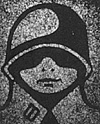 Secondly, there is a vast variation in the terrain of the country. My first sight of the
country was an expanse of sand dunes, the second was perfectly flat grass lands. Then there are the cultivated paddy fields, the abandoned ones, the swamps, the forests, the jungle of varying types, the high plateaux, the mountains all crowded in an area the size of the State of Washington here in the U.S. Each of these, and others, are of sufficient extent to be considered separately as locales for entire small scale campaigns. Add to this the street fighting of Tet 68, and the constant war of posts in the small towns and around bridges, etc., and you have enormous selection of different possible situations.
Secondly, there is a vast variation in the terrain of the country. My first sight of the
country was an expanse of sand dunes, the second was perfectly flat grass lands. Then there are the cultivated paddy fields, the abandoned ones, the swamps, the forests, the jungle of varying types, the high plateaux, the mountains all crowded in an area the size of the State of Washington here in the U.S. Each of these, and others, are of sufficient extent to be considered separately as locales for entire small scale campaigns. Add to this the street fighting of Tet 68, and the constant war of posts in the small towns and around bridges, etc., and you have enormous selection of different possible situations.
A third potential source of interest lies in the diversity of the troops on each side. The Americans seem to come in more varieties than ever before; regular infantry and artillery, paratroopers, "light" infantry, airmobile infantry and artillery, tankers, mechanised infantry, armoured cavalry, marines, reverine troops - all distinctive, and these are only some - add the special forces with their Civilian Irregular Defence Groups (including companies made up of nearly every Asiatic Nationality), the ranger companies, the long range patrollers and you have every reason to be confused. (This, of course, is slighting the Air Force and Navy, who come in several variations themselves).
The South Vietnamese have a positively French liking for distinctive units until a few years ago they still had an elite company in each battalion until us spoil sport Yankees talked them into combining these into independent Ranger battalions. Their women seem to have a greater part in their service than Westerners are used to. One of the Ranger Battalions has a woman major, for instance, and the Vietnamese WACs assigned to the Airborne Division train and jump with the fighting men. To add to the confusion, the Vietnamese on both sides, are organised in hierarchies with regulars at the top and various grades of regional and local troops below them.
Finally, to make rule-devising a greater challenge, the passage of time must be understood. Rules devised for the 1966 period will be only partly applicable to 1970 - and would be hopelessly wrong for 1962. It seems to'me that, although everyone knows the war has been going on for a very long time, we often talk about it as if it has been the same from the beginning. This is a basic error, both for the political commentator and the wargamer. The weapons, training, and quality of troops with the same title has changed greatly over the 14 years since fighting broke out again in the South -- and has been anything but constant in the seven years since American ground troops moved in.
What I propose to do, then, is to study specific types of action -- airmobile operations in moderate forest, for instance, in a given period. I doubt very much if a good set of rules for patrolling in the Rung Sat tidal swamp and patrolling in the central highlands will have much in common. At any rate, we shall see.
My enumeration of troop types above is in no way meant to slight the U.S. Coast Guard, the Australians, the New Zealanders, the Koreans, the Royal Thai Army, the Phillipinos, the Nung Mercenaries, or any of the various types of Montagnards -- with all of whom I prefer to keep on good terms!
Back to Table of Contents -- Wargamer's Newsletter # 115
To Wargamer's Newsletter List of Issues
To MagWeb Master Magazine List
© Copyright 1971 by Donald Featherstone.
This article appears in MagWeb.com (Magazine Web) on the Internet World Wide Web.
Other articles from military history and related magazines are available at http://www.magweb.com